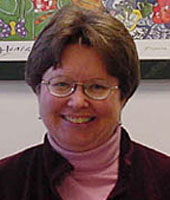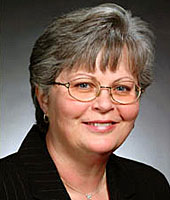AMES, Iowa -- Parents probably wouldn't take their kids to eat at a restaurant that hadn't passed state health code inspection. And yet many Iowa parents routinely drop their children off at home-based child care providers that aren't monitored by the state to ensure they're following proper health and safety standards.
That's according to a pair of Iowa State University researchers who study the state's child care providers. On Oct. 10, they urged Iowa legislators to explore greater monitoring of the state's child care facilities.
ISU Associate Professor of Human Development and Family Studies Susan Hegland and Kathlene Larson, research director of The Community Development - Data Information and Analysis Laboratory (CD-DIAL) at Iowa State, have researched home-based family child care providers in Iowa, Kansas, Missouri and Nebraska. They were invited to present a summary of their research to Iowa legislators on the Home-Based Child Care Study Committee as they debate future funding for improving access to child care within the state.
The 20-percent regulation
Current regulation requires just 20 percent of those child care providers who have registered with the state to be inspected annually -- and most of those are only inspected in response to complaints, according to Hegland. In their report to the committee, the ISU researchers wrote that "the current regulatory system for family child care providers (i.e., registration without required monitoring) is confusing and frustrating to parents and providers."
"Getting not only parents, but public policymakers to understand that when you start to combine children from more than one family, or you get so many children that there aren't enough adults to care properly for the children, brings some new issues to them," said Larson. "Parents assume there are basic safety and health precautions that are being taken, when in fact they may not be."
"I think there are some misperceptions. First of all, that increasing registration (with the state) increases regulation," said Hegland. "And because only 20 percent of registered providers are visited very year -- and in our data, we've seen where some providers have never been visited -- there is a real concern."
Hegland and Larson have built baseline information on education and wage levels of the early care and education (ECE) workforce within the state. Their 2006 study, "Benefits, Rewards & Support: Incentives to Build Quality & Reduce Turnover in the Iowa Child Care Workforce" estimated that, excluding care provided through informal arrangements where money is not exchanged for services, Iowa has more than 12,000 facilities (centers or in-home) providing early care and education to its more than 570,000 children under the age of 13 years. Excluding preschool programs housed in public schools and informal child care arrangements where there is no reported exchange of money, Iowa's child care workforce alone employs more than 17,000 persons.
The ISU researchers reported these statistics about the Iowa family child care workforce to legislators:
- The average education level is 12.9 years -- slightly more than a high school diploma
- The average annual income from a home-based business is $14,709
- The average annual business expenses are $9,450
- The average net profit is $5,259, or $2.02 per hour (assuming a 50-hour work week)
- The estimated turnover rate among family child care providers in Iowa is between 20-40 percent
- The estimated turnover rate for non-publicly funded center programs during 2004 was 20 percent.
In need of incentives
Because of the high turnover rate in the field, Hegland and Larson told the committee that incentives that encourage recruitment, retention and professional development are needed. They said that while Iowa has taken some positive steps in terms of incentives through its Quality Rating System -- which rewards registered providers for achieving certain levels of competency and quality -- more needs to be done.
"The Quality Rating System has been very well received," said Hegland. "Over 800 centers and family child care providers have gone into the Quality Rating System and have received financial incentives for demonstrating these certain requirements.
"But two other concerns that providers have are lack of access to health insurance and retirement pay in terms of a pension," she said. "We need to look harder at how to make that available because many providers who really wanted to stay in the field felt they were forced to leave because of this lack of access to health insurance and to retirement benefits. And they can't afford it now on what they're earning."
The ISU researchers urged legislators to look beyond a single solution to improving child care within the state.
"Just as the topic of incentives is complex, so also is solving the issue of how to make sure parents have good choices for programs that will keep their children safe," they wrote in their report. "Focusing solely on incentives OR regulations OR monitoring will not solve the problem."
Two of the ISU studies on family child care providers are available through the CD-DIAL Web site at http://www.extension.iastate.edu/cd-dial/samples.asp.

